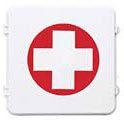First Aid for Seizures

First aid for seizures involves responding in ways that can keep the person safe until the seizure stops by itself. Here are a few things you can do to help someone who is having a generalized tonic-clonic (grand mal) seizure:
- Keep calm and reassure other people who may be nearby.
- Prevent injury by clearing the area around the person of anything hard or sharp.
- Ease the person to the floor and put something soft and flat, like a folded jacket, under his head.
- Remove eyeglasses and loosen ties or anything around the neck that may make breathing difficult.
- Time the seizure with your watch. If the seizure continues for longer than five minutes without signs of slowing down or if a person has trouble breathing afterwards, appears to be injured, in pain, or recovery is unusual in some way, call 911.
- Do not hold the person down or try to stop his movements.
- Contrary to popular belief, it is not true that a person having a seizure can swallow his tongue. Do not put anything in the person’s mouth. Efforts to hold the tongue down can injure the teeth or jaw.
- Turn the person gently onto one side. This will help keep the airway clear.
- Don't attempt artificial respiration except in the unlikely event that a person does not start breathing again after the seizure has stopped.
- Stay with the person until the seizure ends naturally and he is fully awake.
- Do not offer the person water or food until fully alert
- Be friendly and reassuring as consciousness returns.
- Offer to call a taxi, friend or relative to help the person get home if he seems confused or unable to get home without help.
Here are a few things you can do to help someone who is having a seizure that appears as blank staring, loss of awareness, and/or involuntary blinking, chewing, or other facial movements.
- Stay calm and speak reassuringly.
- Guide him away from dangers.
- Block access to hazards, but don’t restrain the person.
- If he is agitated, stay a distance away, but close enough to protect him until full awareness has returned.
Consider a seizure an emergency and call 911 if any of the following occurs:
- The seizure lasts longer than five minutes without signs of slowing down or if a person has trouble breathing afterwards, appears to be in pain or recovery is unusual in some way.
- The person has another seizure soon after the first one.
- The person cannot be awakened after the seizure activity has stopped.
- The person became injured during the seizure.
- The person becomes aggressive.
- The seizure occurs in water.
- The person has a health condition like diabetes or heart disease or is pregnant.
Related Links
- Epilepsy Foundation First Aid
- http://www.epilepsy.com/epilepsy/firstaid_seizures
- Newsroom
- eCommunities
- For links to other epilepsy organizations and educational resources, see Resources
- Links to non-federal organizations are provided solely as a service to our users. These links do not constitute an endorsement of these organizations or their programs by CDC or the federal government, and none should be inferred. CDC is not responsible for the content of the individual organization Web pages found at these links.
Get email updates
To receive email updates about this page, enter your email address:
Contact Us:
- Centers for Disease Control and Prevention
Epilepsy
4770 Buford Hwy, NE
MS K-51
Atlanta, GA 30341 - 800-CDC-INFO
(800-232-4636)
TTY: (888) 232-6348
24 Hours/Every Day - cdcinfo@cdc.gov

